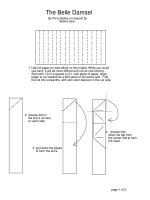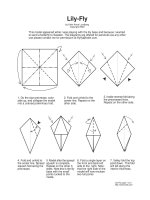Tài liệu Kim ppt
Bạn đang xem bản rút gọn của tài liệu. Xem và tải ngay bản đầy đủ của tài liệu tại đây (741.94 KB, 5 trang )
Brenda Hoddinott
H-05 BEGINNER: FOCUS ON PEOPLE
The most common mistake that artists
make when drawing faces, is to draw the
eyes too high on the head.
In this fun cartoon of a young girl, I show
you how to render super simple facial
proportions, and the shiny texture of dark
straight hair.
This project is divided into the following three sections:
INTRODUCTION: I discuss the process of using hatching to create the form and texture of
dark, straight, shiny hair.
DRAWING KIM’S FACE AND FEATURES: You follow along with me to outline the
lower section of Kim’s head, and her eyes, nose, mouth, and eyebrows.
ADDING SHINY HAIR: You use curved hatching lines to draw Kim’s hair.
Suggested drawing supplies include good quality drawing paper, HB and 4B graphite pencils,
and a kneaded and vinyl eraser. Skills presented in this lesson include: drawing basic facial
proportions; shading dark hair with hatching, and rendering the texture of straight hair.
Recommended for artists from age 10 to adult, as well as fine art educators in home school,
academic, and recreational environments.
5 PAGES – 10 ILLUSTRATIONS
Published by Hoddinott Fine Art Publishers, Halifax, NS, Canada – 2003 (Revised 2006)
Copyright to all articles, images, text, projects, lessons and exercises within this drawing class belong to Brenda Hoddinott and
may not be reproduced or used for any commercial purposes whatsoever without the written permission of Brenda Hoddinott.
Web site or
2
INTRODUCTION
In this fun cartoon of a young girl, I show you how to accurately render super simple facial
proportions, and the shiny texture of dark straight hair. Proportion is the relationship in size of
one component of a drawing to another or others. Texture is the surface detail of an object, as
defined in a drawing with various shading techniques. The senses of touch and sight help identify
the surface texture of an object.
The texture of the hair is rendered with hatching. Hatching is a
series of lines (called a set) drawn closely together to give the
illusion of values. Values are the different shades of gray created
by varying the density (whether the lines are close together or far
apart) of the hatching lines. Straight hair looks much more realistic
when you use curved lines instead of straight lines. Curved lines
are created when a straight line curves (or bends), and can be
drawn thick or thin.
In the close-up drawing of a shiny section of hair (on the left), the
hatching lines are slightly curved, and are several different lengths.
Also, the lines are not abrupt stops, but rather feathered (or ragged)
to give a more realistic appearance.
The illusion of form on the upper section of Kim’s head (the
drawing on the right) is created with:
Curved hatching lines that follow the shape of her skull
The contrast between the light and dark values.
Contrast measures the degree of difference between the light
and dark values within the shading of a drawing. Form is the
illusion of the three-dimensional structure of a shape, such as
a circle, square or triangle, created in a drawing with shading
and/or perspective. Shape refers to the outward outline of a
form. Basic shapes include circles, squares and triangles.
DRAWING KIM’S FACE AND FEATURES
Grab your drawing supplies and follow along with me to outline the lower section of Kim’s head
and her eyes, nose, mouth, and eyebrows.
ILLUSTRATION 5-01
1. Use your HB pencil to draw a U-shape to represent the
lower half of the head.
Make sure that you leave lots of room on your paper for the
top half of her head. This whole U-shape (face) is in the
lower half of your drawing space.
Copyright to all articles, images, text, projects, lessons and exercises within this drawing class belong to Brenda Hoddinott and
may not be reproduced or used for any commercial purposes whatsoever without the written permission of Brenda Hoddinott.
Web site or
3
ILLUSTRATION 5-02
2. Draw the ears.
The tops of ears will approximately line up horizontally
with the eyebrows. The bottoms of the ears will line up
with the bottom of the nose.
ILLUSTRATION 5-03
3. Draw Kim’s eyes and eyebrows.
Her almond shaped eyes are slightly lower than the
tops of the ears. Use your 4B pencil to shade in each
eye, leaving a tiny white spot (the highlight) in each,
to help make them look shiny. A highlight is a tiny
bright spot where the light bounces off the shiny
surface of the eye. A slightly curved short line above
each eye represents the eyebrows.
ILLUSTRATION 5-04
4. Add her nose and mouth.
Draw an oval shape, below the eyes as her
nose. Note that the bottom of the nose lines
up horizontally with the bottom of the ears.
Draw a curved line as the mouth. Add a tiny
downward curve on each end of the mouth.
ADDING SHINY HAIR
In this section, you use curved hatching lines to draw Kim’s hair.
ILLUSTRATION 5-05
5. Use your 4B pencil to draw the
curved hatching lines that
indicate the hair.
The curved hatching lines are
several different lengths and
values.
The hairline around the forehead
and the edges of the center part in
the hair are not solid lines; rather
they are jagged edges.
Copyright to all articles, images, text, projects, lessons and exercises within this drawing class belong to Brenda Hoddinott and
may not be reproduced or used for any commercial purposes whatsoever without the written permission of Brenda Hoddinott.
Web site or
4
ILLUSTRATION 5-06 ILLUSTRATION 5-07
6. Draw the buns (or whatever
you wish to call them) on
either side of her head.
First of all, outline two oval
shapes on either side of her
head with a HB pencil. Make
sure you leave the ears in
front of the buns. Then, use
your 4B pencil to draw the
hatching lines that indicate
the shiny texture of the buns.
Sign your name, put the date on
the back of your drawing paper,
pat yourself on the head, give
yourself a big hug and choose
another drawing project!
Copyright to all articles, images, text, projects, lessons and exercises within this drawing class belong to Brenda Hoddinott and
may not be reproduced or used for any commercial purposes whatsoever without the written permission of Brenda Hoddinott.
Web site or
5
BRENDA HODDINOTT - BIOGRAPHY
As a self-educated teacher, visual artist, portraitist, forensic artist, and illustrator, Brenda
Hoddinott utilizes diverse art media including graphite, technical pen, colored pencil, chalk
pastel, charcoal, conté crayon, and oil paints.
My philosophy on teaching art is to focus primarily on the
enjoyment aspects while gently introducing the technical and
academic. Hence, in creating a passion for the subject matter,
the quest for knowledge also becomes enjoyable.
>Brenda Hoddinott<
Born in St. John’s, Newfoundland, Brenda grew up in the small town of Corner Brook. She
developed strong technical competencies with a personal commitment to self directed learning,
and the aid of assorted “Learn to Draw” books.
During Brenda’s twenty-five year career as a self-educated civilian forensic artist, numerous
criminal investigation departments employed Brenda’s skills, including Royal Canadian
Mounted Police and municipal police departments. In 1992, Brenda was honored with a
commendation from the Royal Canadian Mounted Police, and in 1994, she was awarded a
Certificate of Membership from “Forensic Artists International”.
Her home-based art career included graphic design, and teaching recreational drawing and
painting classes. As supervisor of her community’s recreational art department, Brenda hired and
trained teachers, and designed curriculum for several children’s art programs. In 1998, Brenda
chose to end her eighteen-year career as an art educator in order to devote more time to writing,
drawing, painting, and developing her websites.
Drawspace
incorporates her unique style and innovative approach to
curriculum development. This site offers downloadable and printable drawing classes for
students of all abilities from the age of eight through adult. Students of all ages, levels and
abilities have praised the simple step-by-step instructional approach. This site is respected as a
resource for fine art educators, home schooling programs, and educational facilities throughout
the world.
LEARN-TO-DRAW BOOKS BY BRENDA HODDINOTT
Drawing for Dummies: Wiley Publishing, Inc., New, York, NY, this 336 page book is
available on various websites and in major bookstores internationally. Drawing for Dummies
is now available in Dutch, Bulgarian, Spanish, French, and German.
The Complete Idiot’s Guide to Drawing People: Winner of the Alpha-Penguin Book of the
Year Award 2004, Alpha - Pearson Education – Macmillan, Indianapolis, IN, this 360 page
book is available on various websites and in major bookstores internationally.









